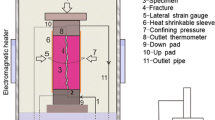Abstract
In this paper, a thermal resistance model for an energy wall using the example of thermo-active seal panels is presented. In the developed model, the resistances of the pipes as well as the resistance of the structure itself are considered. The resistance model is transferred to a 2D finite difference model, which itself is implemented into the general 3D subsurface heat and flow transport code SHEMAT-Suite. This coupling of a semi-analytical model with a numerical code avoids a complete discretisation of the model domain and thus enables fast computing times. This new approach has been verified by pure finite element simulations and by laboratory tests.










Similar content being viewed by others
References
Adam D, Markiewicz R (2009) Energy from earth-coupled structures, foundations, tunnels and sewers. Géotechnique 59(3):229–236
Brandl H (2006) Energy foundations and other thermo-active ground structures. Géotechnique 56(2):81–122
Clauser C (ed) (2003) Numerical simulation of reactive flow in hot aquifers using SHEMAT and processing SHEMAT. Springer, Heidelberg
Franzius JN, Pralle N (2011) Turning segmental tunnels into sources of renewable energy. Proc Inst Civ Eng 164(1):35–40
Glück B (1982) Strahlungsheizung—Theorie und Praxis. C.F. Müller, Karlsruhe
Lamarche L, Kajil S, Beauchamp B (2010) A review of methods to evaluate borehole thermal resistances in geothermal heat-pump systems. Geothermics 39(2):187–200
Koschenz M, Dorer V (1999) Interaction of an air system with concrete core conditioning. Energy Build 30(1999):139–145
Kürten S (2011) Use of geothermal energy with thermo-active seal panels. In: Barends et al. (ed) Geotechnical engineering: new horizons. doi:10.3233/978-1-60750-808-3-327
Kürten S, Ziegler M, Olischläger V, Ehrenberg H (2012) Untersuchungen zur Effizienz von thermo-aktiven Abdichtungselementen zur thermischen Nutzung des Untergrunds. Bautechnik 89(3):192–199
Kürten S, Ziegler M, Ehrenberg H, Mottaghy D (2013) Beschreibung des Einflusses einer Grundwasserströmung auf den Wärmeertrag von flächigen thermo-aktiven Bauteilen. In: österreichischer Ingenieur- und Architekten-Verein (ed) 9. österreichische Geotechniktagung mit “Vienna-Terzaghi Lecture”, 24. und 25. Jänner 2013: 173–182, ISBN 978-3-902450-02-9
Kürten S, Mottaghy D, Ziegler M (2013) Wärmeübergangswiderstand bei flächigen thermo-aktiven Bauteilen am Beispiel thermo-aktiver Abdichtungselemente. Bautechnik 90(7):387–394
Mihalakakou G (2002) On estimating soil surface temperature profiles. Energy Build 34:251–259
Mottaghy D, Dijkshoorn L (2012) Implementing an effective finite difference formulation for borehole heat exchangers into a heat and mass transport code. Renew Energy 45:59–71
Rath V, Wolf A, Bücker M (2006) Joint three-dimensional inversion of coupled groundwater flow and heat transfer based on automatic differentiation: sensitivity calculation, verification and synthetic examples. Geophys J Int 167(1):453–466
Schneider M, Moormann C (2010) GeoTU6—a geothermal research project for tunnels. Tunnel 2:14–21
VDI-Wärmeatlas (2006) 10. Auflage. Springer, Heidelberg
Acknowledgments
The development of the thermo-active seal panels was funded by the Federal Office for Building and Regional Planning (BBR) and was done in cooperation with the company NAUE GmbH & Co. KG. The development of the thermal resistance model is funded by the “Deutsche Bundesstiftung Umwelt” (DBU). The authors thanks all of them for the support.
Author information
Authors and Affiliations
Corresponding author
Rights and permissions
About this article
Cite this article
Kürten, S., Mottaghy, D. & Ziegler, M. A new model for the description of the heat transfer for plane thermo-active geotechnical systems based on thermal resistances. Acta Geotech. 10, 219–229 (2015). https://doi.org/10.1007/s11440-014-0311-6
Received:
Accepted:
Published:
Issue Date:
DOI: https://doi.org/10.1007/s11440-014-0311-6




